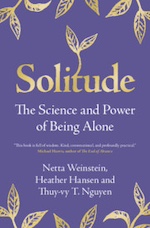 Solitude: The Science and Power of Alone Time, by Netta Weinstein, Heather Hanson, and Thuy-vy T. Nguyen. Cambridge, UK: Cambridge University Press, 2024.
Solitude: The Science and Power of Alone Time, by Netta Weinstein, Heather Hanson, and Thuy-vy T. Nguyen. Cambridge, UK: Cambridge University Press, 2024.
As the authors note from the outset of the book, the science of solitude is new but growing quickly, as attested within these pages. Evidence collected for this book reflects thousands of interviews, surveys, conversations and psychology lab sessions, with diverse groups of people by age, gender, ethnicity, and geography. From anecdotes to testimonials, the goal of the authors is to compile a grand picture of solitude and alone time habits and practices, turning these observations into insightful conclusions and helping establish a working sense of solitude for everyday people.
The presentation is congenial, conversational, informal, entertaining, and useful. Two of the authors (Weinstein and Nguyen) are academic psychologists, and one (Hanson) is a science journalist.
Chapter One quickly summarizes the history of eremitism and historical hermits distinct from solitude to focus more broadly for the est of the book on the concept of solitude as relevant to everyone else. (A few historical names — Pascal, Emerson, Thoreau — will recur in later chapters.) The premise of the book is -- as the title of Chapter Two indicates -- that “Everyday Solitude [is] for Everyday People.” In short, solitude offers a range of applications that can function within the needs of everyone.
Solitude is simply time alone, and how one chooses to be aware of solitude in daily life, or occasionally as disruption or curiosity can differ widely per individual. Scientists still do not define solitude broadly because solitude applies individually, and even varies within one person. But enough is known by psychology today to present vectors of solitude, or, rather, forms of solitude expression, as the authors do.
These solitudes are presented as four broad types: 1) complete solitude, or Buddha-style solitude, 2) private solitude, or down-to-earth-solitude, 3) companionate solitude, or partners-in-solitude, and 4) public solitude, or Alone in a Crowd. Thousands of interviews and research studies illustrate these wide applications, and the authors set out to document representative examples.
Solitude is distinct from involuntary aloneness, and is specifically not loneliness. Solitude is a natural condition of daily life’s ebb and flow, contrasting one moment to another individually, socially, collectively, or in conscious withdrawal, however long. A highlight of a conscious solitude is the benefit of autonomy, resilience, and a flow with nature.
To illustrate the benefits of solitude, the authors use the metaphor of a compass. Here the directional points are not geological or cultural but show the relations between what solitude does. So, north represents self-refection; south: rest, relaxation, and renewal; east: enrichment and creativity; west peak experiences and the good life. Thus we start with self, yielding a comfort zone, then moving to engaging with life and peaking with an internalization of the benefits of solitude. This parsing of sequential stages is essential for the average pursuant of solitude because it provides a psychologically healthy approach that builds on experience as much as psychological observation in the first place. Nothing need be rushed, skipped, or assumed. The auhors present a path or way, reflecting both science and historical wisdom.
Two chapter titles encourage beginners as well as seasoned practitioners. Chapter 9: "Can We Get Better at Being Alone?" and the final chapter, 10: "Solitude Across a Lifetime."
All this may sound familiar to readers comfortable with the subject of hermits and eremitism. But reading the many conversational snippets and anecdotes in this book will be pleasant confirmation that many average people are already attracted to the benefits of solitude and are waiting for a practical presentation and "how to." To further motivate readers, the authors even offer a helpful concluding “solitude checklist."
Take your solitude pulse.
Start small, stay mighty.
Adopt a thoughtful approach.
Create a framework.
Be curious.
Opt for a low-sensory environment.
Be open to experimentation.
Believe in belonging.
Practice “integrated emotion regulation."
Beware “sneaky infiltrators."
Plan for and protect periods of solitude.
This book is a delightful excursion, easy to read, easy to identify with the many sources the authors include, and a refreshingly positive invitation to incorporate solitude into daily life.
© 2025, Hermitary.com
